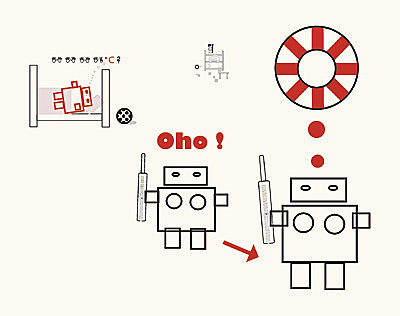|
(b. 1976) graduated from the Department of Graphic Art (Prof. Stanisław Kluska) at the Katowice branch of the Fine Arts Academy in Krakow, Poland.
Her picture stories portray everyday life in a world in which computers are no longer fetishes of the present but just another tool people have embraced. Jabłońska creates her comic stories on the computer, employing clip art images and other commonly accessible, standard elements of the personal computer. They are especially familiar to computer users because their subject-matter is the everyday and also because they are composed of universal, ready-made elements and pictograms. Here, however, life does not follow the usual path. It is subjected to the poetry of life encounters (illness, cosmic dreams, making pancakes) but under the rules of geometry. Just as computers operate on the basis of zeros and ones, the world of Jabłońska’s characters is based on circles and squares. The language they speak only partially resembles ours. Reality in her comic stories thus gives the impression of a strange and familiar logic, which is at the same time not one we typically live under. Perhaps it is the digital logic of virtual reality. She says of her works: “I use geometric forms to express contradictions within crucial elements of everyday life, including an overall harmony with visible and invisible worlds, a sense of humor, family life, pets and various tools.”

Empfohlene Artikel

|
|
Author dreaming of a future without censorship we have never got rid of.
It seems, that people don‘t care while it grows stronger again.
|

|
|
The editors of Umělec have decided to come up with a list of ten artists who, in our opinion, were of crucial importance for the Czech art scene in the 1990s. After long debate and the setting of criteria, we arrived at a list of names we consider significant for the local context, for the presentation of Czech art outside the country and especially for the future of art. Our criteria did not…
|

|
|
There is nothing that has not already been done in culture, squeezed or pulled inside out, blown to dust. Classical culture today is made by scum. Those working in the fine arts who make paintings are called artists. Otherwise in the backwaters and marshlands the rest of the artists are lost in search of new and ever surprising methods. They must be earthbound, casual, political, managerial,…
|

|
|
Mit Anleihen aus Märchen, Fabeln und Science-Fiction drehen sich die Arbeiten von Magda Tóthová um moderne Utopien, Gesellschaftsentwürfe und deren Scheitern. Persönliche und gesellschaftliche Fragen, Privates und Politisches werden behandelt. Die Personifizierung ist das zentrale Stilmittel für die in den Arbeiten stets mitschwingende Gesellschaftskritik und das Verhandeln von Begriffen, auf…
|
|







Kommentar
Der Artikel ist bisher nicht kommentiert wordenNeuen Kommentar einfügen